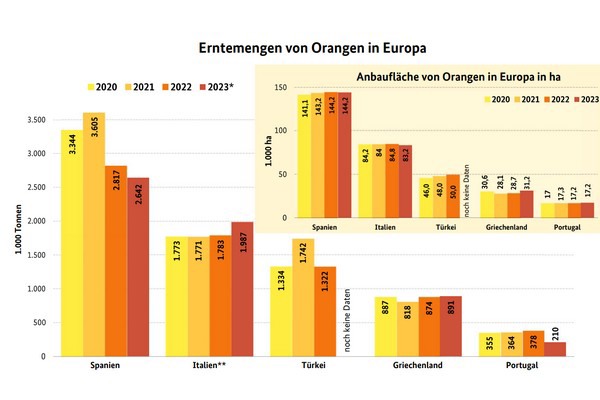Oranges continued to be dominated by Spanish imports, with varieties such as Navelina, Navel, Salustiana, Navelate, and Lane Late leading the market. According to the Federal Office for Agriculture and Food (BLE), the Spanish campaign had passed its peak, and quantities were slightly declining. Turkish imports of Navel varieties followed in significance. Imports from Morocco, Egypt, and Greece rounded off the product range. Egyptian fruits, especially Valencia Late, significantly gained in importance. The variable and locally cool weather improved storage options in some places.

Throughout the reporting week, quotations remained essentially unchanged, with minor fluctuations aside. The blood orange segment was dominated by Italian Tarocco, complemented by Italian Cara Cara, Spanish Cara Cara, Sanguinelli, and Kirkwood. This variety generated brisk demand in many markets. For instance, in Frankfurt, the Moro Nucellare variety in small caliber found buyers at €1.80 per kg. In Hamburg, the red-fleshed Sicilian variety Tarocco Lempso made its debut; it impressed with its unique aroma and high juice content. Customers were expected to pay €14 for the 7-kg crate.
Apples
Domestic products continuously dominated the scene. Generally, sales proceeded in a calm manner. Retailers rarely had reason to modify their initial calls.
Pears
The offering was mainly composed of Turkish Santa Maria and Deveci, Dutch Xenia and Conference. Following in significance were Italian Abate Fetel and Santa Maria, though their supplies were already slightly limited.
Grapes
South African imports shaped the business. Demand was mostly very friendly, yet availability was sufficient to satisfy interest. Evaluations often remained at the previous level.
Small citrus fruits
Due to carnival, marketing was sometimes a bit sluggish; on the other hand, the wet and cold weather improved storage options. Mandarins were now clearly dominating the scene: They primarily came from Spain and Israel.
Lemons
Spanish Primofiori dominated, with Turkish Lama complementing the scene. A few imports from Egypt arrived occasionally but sometimes had quality weaknesses.
Bananas
Supply and demand were generally balanced. Therefore, retailers rarely had to correct their previous calls.
Cauliflower
The assortment was mostly made up of Italian, Spanish, and French shipments. Although overall availability was limited, demand could be met without effort.
Lettuce
For iceberg lettuce, only Spanish deliveries were accessible. Availability fluctuated occasionally, resulting in inconsistent quotations: overall, however, they tended to rise slightly.
Cucumbers
Spanish offers formed the basis of the offering, but Dutch arrivals were seemingly gaining significance. Retailers often slightly lowered their demands due to increased Central European deliveries, which promptly improved storage options.
Tomatoes
Overall, a very wide range of selections and prices was available. Evaluations developed inconsistently.
Bell peppers
Spanish offers dominated the scene, flanked by Turkish and Moroccan imports. Business was very inconsistent, and accordingly, quotations developed.
Source: BLE
